斯坦福卫生经济学教材(Health Economics)杰伊·巴塔查里亚《健康经济学》课程教学资源(PPT课件,英文版)Chapter 19 POPULATION AGING AND THE FUTURE OF HEALTH POLICY
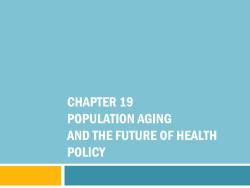
CHAPTER 19 POPULATION AGING AND THE FUTURE OF HEALTH POLICY
CHAPTER 19 POPULATION AGING AND THE FUTURE OF HEALTH POLICY
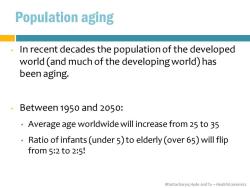
Population aging In recent decades the population of the developed world (and much of the developing world)has been aging. Between 1950 and 2050: Average age worldwide will increase from 25 to 35 Ratio of infants(under 5)to elderly (over 65)will flip from 5:2 to 2:5! Bhattacharya,Hyde and Tu-HealthEconomics
Bhattacharya, Hyde and Tu – Health Economics Population aging • In recent decades the population of the developed world (and much of the developing world) has been aging. • Between 1950 and 2050: • Average age worldwide will increase from 25 to 35 • Ratio of infants (under 5) to elderly (over 65) will flip from 5:2 to 2:5!
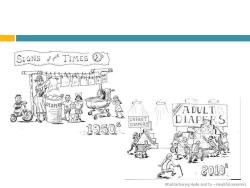
SIGNS TIMES E DIAPERS ADULT INFANT 195Q DIAPERS 2010 Bhattacharya,Hyde and Tu-HealthEconomics
Bhattacharya, Hyde and Tu – Health Economics
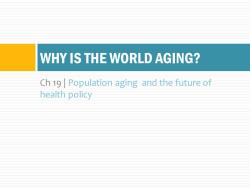
WHY IS THE WORLD AGING? Ch 19 Population aging and the future of health policy
Ch 19 | Population aging and the future of health policy WHY IS THE WORLD AGING?
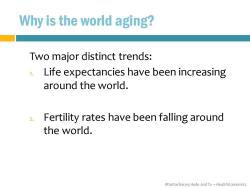
Why is the world aging? Two major distinct trends: Life expectancies have been increasing around the world. 2.Fertility rates have been falling around the world. Bhattacharya,Hyde and Tu-HealthEconomics
Bhattacharya, Hyde and Tu – Health Economics Why is the world aging? Two major distinct trends: 1. Life expectancies have been increasing around the world. 2. Fertility rates have been falling around the world
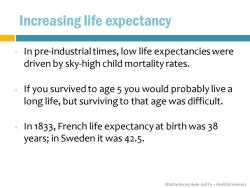
Increasing life expectancy In pre-industrial times,low life expectancies were driven by sky-high child mortality rates. If you survived to age 5 you would probably live a long life,but surviving to that age was difficult. In 1833,French life expectancy at birth was 38 years;in Sweden it was 42.5. Bhattacharya,Hyde and Tu-HealthEconomics
Bhattacharya, Hyde and Tu – Health Economics Increasing life expectancy • In pre-industrial times, low life expectancies were driven by sky-high child mortality rates. • If you survived to age 5 you would probably live a long life, but surviving to that age was difficult. • In 1833, French life expectancy at birth was 38 years; in Sweden it was 42.5
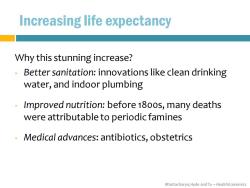
Increasing life expectancy Why this stunning increase? Better sanitation:innovations like clean drinking water,and indoor plumbing Improved nutrition:before 18oos,many deaths were attributable to periodic famines Medical advances:antibiotics,obstetrics Bhattacharya,Hyde and Tu-HealthEconomics
Bhattacharya, Hyde and Tu – Health Economics Increasing life expectancy Why this stunning increase? • Better sanitation: innovations like clean drinking water, and indoor plumbing • Improved nutrition: before 1800s, many deaths were attributable to periodic famines • Medical advances: antibiotics, obstetrics

Declining fertility rates In order for a population to maintain its size from generation to generation,each woman must give birth to about 2.1 children during her lifetime. This special fertility rate is often called the population replacement fertility rate. In the last few decades,however,the total fertility rate in the developed world has fallen below that level. Bhattacharya,Hyde and Tu-HealthEconomics
Bhattacharya, Hyde and Tu – Health Economics Declining fertility rates • In order for a population to maintain its size from generation to generation, each woman must give birth to about 2.1 children during her lifetime. • This special fertility rate is often called the population replacement fertility rate. • In the last few decades, however, the total fertility rate in the developed world has fallen below that level
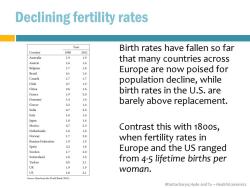
Declining fertility rates Year Birth rates have fallen so far Country 1980 2011 Australia 1.9 1.9 Austria 6 1 that many countries across Belgium 1.8 1.8 Europe are now poised for Brazil 41 Canada 1.7 Chile 7 1.9 population decline,while China 26 1.6 France 2.0 birth rates in the U.S.are Germany 14 Greece 1.4 barely above replacement. India 47 2.6 Italy 14 Japan Mexico 4 23 Netherlands 8 Contrast this with 1800s, Norway 2.0 Russian Federation 15 when fertility rates in Spain 2 4 Sweden 2.0 Europe and the US ranged Switzerland 6 Turkey 21 from 4-5 lifetime births per UK 1.9 1.9 US 1.8 2.1 woman. Soure:Data from the World Bank (2012). Bhattacharya,Hyde and Tu-HealthEconomics
Bhattacharya, Hyde and Tu – Health Economics Declining fertility rates Birth rates have fallen so far that many countries across Europe are now poised for population decline, while birth rates in the U.S. are barely above replacement. Contrast this with 1800s, when fertility rates in Europe and the US ranged from 4-5 lifetime births per woman
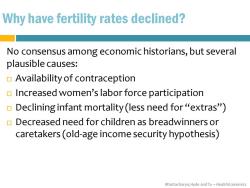
Why have fertility rates declined? No consensus among economic historians,but several plausible causes: Availability of contraception Increased women's labor force participation Declining infant mortality(less need for "extras") Decreased need for children as breadwinners or caretakers(old-age income security hypothesis) Bhattacharya,Hyde and Tu-HealthEconomics
Bhattacharya, Hyde and Tu – Health Economics Why have fertility rates declined? No consensus among economic historians, but several plausible causes: Availability of contraception Increased women’s labor force participation Declining infant mortality (less need for “extras”) Decreased need for children as breadwinners or caretakers (old-age income security hypothesis)
按次数下载不扣除下载券;
注册用户24小时内重复下载只扣除一次;
顺序:VIP每日次数-->可用次数-->下载券;
- 斯坦福卫生经济学教材(Health Economics)杰伊·巴塔查里亚《健康经济学》课程教学资源(PPT课件,英文版)Chapter 18 THE AMERICAN MODEL.ppt
- 斯坦福卫生经济学教材(Health Economics)杰伊·巴塔查里亚《健康经济学》课程教学资源(PPT课件,英文版)Chapter 17 THE BISMARCK MODEL - SOCIAL HEALTH INSURANCE.ppt
- 斯坦福卫生经济学教材(Health Economics)杰伊·巴塔查里亚《健康经济学》课程教学资源(PPT课件,英文版)Chapter 16 THE BEVERIDGE MODEL - NATIONALIZED HEALTH CARE.ppt
- 斯坦福卫生经济学教材(Health Economics)杰伊·巴塔查里亚《健康经济学》课程教学资源(PPT课件,英文版)Chapter 15 THE HEALTH POLICY CONUNDRUM.ppt
- 斯坦福卫生经济学教材(Health Economics)杰伊·巴塔查里亚《健康经济学》课程教学资源(PPT课件,英文版)Chapter 14 HEALTH TECHNOLOGY ASSESSMENT.ppt
- 斯坦福卫生经济学教材(Health Economics)杰伊·巴塔查里亚《健康经济学》课程教学资源(PPT课件,英文版)Chapter 13 TECHNOLOGY AND THE PRICE OF HEALTH CARE.ppt
- 斯坦福卫生经济学教材(Health Economics)杰伊·巴塔查里亚《健康经济学》课程教学资源(PPT课件,英文版)Chapter 12 PHARMACEUTICALS AND THE ECONOMICS OF INNOVATION.ppt
- 斯坦福卫生经济学教材(Health Economics)杰伊·巴塔查里亚《健康经济学》课程教学资源(PPT课件,英文版)Chapter 11 MORAL HAZARD.ppt
- 斯坦福卫生经济学教材(Health Economics)杰伊·巴塔查里亚《健康经济学》课程教学资源(PPT课件,英文版)Chapter 10 ADVERSE SELECTION IN REAL MARKETS.ppt
- 斯坦福卫生经济学教材(Health Economics)杰伊·巴塔查里亚《健康经济学》课程教学资源(PPT课件,英文版)Chapter 01 WHY HEALTH ECONOMICS?.ppt
- 斯坦福卫生经济学教材(Health Economics)杰伊·巴塔查里亚《健康经济学》课程教学资源(试卷习题,英文版)课后判断题及答案 Ch 9 Adverse Selection - The Rothschild-Stiglitz Model.pdf
- 斯坦福卫生经济学教材(Health Economics)杰伊·巴塔查里亚《健康经济学》课程教学资源(试卷习题,英文版)课后判断题及答案 Ch 8 Adverse Selection - Akerlof’s Market for Lemons.pdf
- 斯坦福卫生经济学教材(Health Economics)杰伊·巴塔查里亚《健康经济学》课程教学资源(试卷习题,英文版)课后判断题及答案 Ch 7 Demand for Insurance.pdf
- 斯坦福卫生经济学教材(Health Economics)杰伊·巴塔查里亚《健康经济学》课程教学资源(试卷习题,英文版)课后判断题及答案 Ch 6 The Hospital Industry.pdf
- 斯坦福卫生经济学教材(Health Economics)杰伊·巴塔查里亚《健康经济学》课程教学资源(试卷习题,英文版)课后判断题及答案 Ch 5 The Labor Market for Physicians.pdf
- 斯坦福卫生经济学教材(Health Economics)杰伊·巴塔查里亚《健康经济学》课程教学资源(试卷习题,英文版)课后判断题及答案 Ch 4 Socioeconomic Disparities in Health.pdf
- 斯坦福卫生经济学教材(Health Economics)杰伊·巴塔查里亚《健康经济学》课程教学资源(试卷习题,英文版)课后判断题及答案 Ch 3 Demand for Health:The Grossman Model.pdf
- 斯坦福卫生经济学教材(Health Economics)杰伊·巴塔查里亚《健康经济学》课程教学资源(试卷习题,英文版)课后判断题及答案 Ch 24 Time Inconsistency and Health.pdf
- 斯坦福卫生经济学教材(Health Economics)杰伊·巴塔查里亚《健康经济学》课程教学资源(试卷习题,英文版)课后判断题及答案 Ch 23 Prospect Theory.pdf
- 斯坦福卫生经济学教材(Health Economics)杰伊·巴塔查里亚《健康经济学》课程教学资源(试卷习题,英文版)课后判断题及答案 Ch 22 Obesity.pdf
- 斯坦福卫生经济学教材(Health Economics)杰伊·巴塔查里亚《健康经济学》课程教学资源(PPT课件,英文版)Chapter 02 DEMAND FOR HEALTH CARE.ppt
- 斯坦福卫生经济学教材(Health Economics)杰伊·巴塔查里亚《健康经济学》课程教学资源(PPT课件,英文版)Chapter 20 THE ECONOMICS OF HEALTH EXTERNALITIES.ppt
- 斯坦福卫生经济学教材(Health Economics)杰伊·巴塔查里亚《健康经济学》课程教学资源(PPT课件,英文版)Chapter 21 ECONOMIC EPIDEMIOLOGY.ppt
- 斯坦福卫生经济学教材(Health Economics)杰伊·巴塔查里亚《健康经济学》课程教学资源(PPT课件,英文版)Chapter 22 OBESITY.ppt
- 斯坦福卫生经济学教材(Health Economics)杰伊·巴塔查里亚《健康经济学》课程教学资源(PPT课件,英文版)Chapter 23 PROSPECT THEORY.ppt
- 斯坦福卫生经济学教材(Health Economics)杰伊·巴塔查里亚《健康经济学》课程教学资源(PPT课件,英文版)Chapter 24 TIME INCONSISTENCY AND HEALTH.ppt
- 斯坦福卫生经济学教材(Health Economics)杰伊·巴塔查里亚《健康经济学》课程教学资源(PPT课件,英文版)Chapter 03 CHAPTER 3 DEMAND FOR HEALTH:THE GROSSMAN MODEL.ppt
- 斯坦福卫生经济学教材(Health Economics)杰伊·巴塔查里亚《健康经济学》课程教学资源(PPT课件,英文版)Chapter 04 SOCIOECONOMIC DISPARITIES IN HEALTH.ppt
- 斯坦福卫生经济学教材(Health Economics)杰伊·巴塔查里亚《健康经济学》课程教学资源(PPT课件,英文版)Chapter 05 THE PHYSICIAN LABOR MARKET.ppt
- 斯坦福卫生经济学教材(Health Economics)杰伊·巴塔查里亚《健康经济学》课程教学资源(PPT课件,英文版)Chapter 06 THE HOSPITAL INDUSTRY.ppt
- 斯坦福卫生经济学教材(Health Economics)杰伊·巴塔查里亚《健康经济学》课程教学资源(PPT课件,英文版)Chapter 07 DEMAND FOR INSURANCE.ppt
- 斯坦福卫生经济学教材(Health Economics)杰伊·巴塔查里亚《健康经济学》课程教学资源(PPT课件,英文版)Chapter 08 ADVERSE SELECTION - AKERLOF’S MARKET FOR LEMONS.ppt
- 斯坦福卫生经济学教材(Health Economics)杰伊·巴塔查里亚《健康经济学》课程教学资源(PPT课件,英文版)Chapter 09 ADVERSE SELECTION - THE ROTHSCHILD-STIGLITZ MODEL.ppt
- 兰州交通大学:《微观经济学》课程教学资源(教案大纲)教学大纲 Microeconomics(负责人:李新文).pdf
- 兰州交通大学:《微观经济学》课程教学资源(教案大纲)微观经济学授课教案(打印版).pdf
- 兰州交通大学:《微观经济学》课程教学资源(案例分析)微观经济学教学案例(打印版).pdf
- 《微观经济学》课程教学资源(书籍文献)西方经济学名著选读.pdf
- 兰州交通大学:《微观经济学》课程教学资源(试卷习题)微观经济学各章习题库及参考答案(打印版,共十一章).pdf
- 兰州交通大学:《微观经济学》课程教学资源(试卷习题)微观经济学试题(A卷)试卷(打印版).pdf
- 兰州交通大学:《微观经济学》课程教学资源(试卷习题)微观经济学试卷(A卷)答案(打印版).pdf
